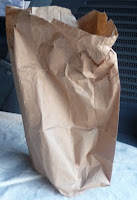 on the back. That was about the only field mark visible in the dim lighting as the head was tucked and the bird was fairly lifeless. Yet, from loads of experience with many similar encounters, I knew the bird was alive since it was still on its feet. Dead birds don't huddle or squat. Blackpoll Warbler immediately came to mind and that was my identification despite the poor look in dim lighting at 6:30 in the morning. The bird was quickly scooped up and placed in a brown paper bag (actual bag shown in photo! Wow.) A simple brown paper bag makes transporting stunned and injured birds easy. Just place inside and crimp the top shut. If you do a good job of crimping, they can't get out. Of course, if the crimp job is not so good and you have a feisty American Redstart, you may have a bird loose in your car. I've had more than one loose bird in the car in the "early days" so I've learned to crimp better.
on the back. That was about the only field mark visible in the dim lighting as the head was tucked and the bird was fairly lifeless. Yet, from loads of experience with many similar encounters, I knew the bird was alive since it was still on its feet. Dead birds don't huddle or squat. Blackpoll Warbler immediately came to mind and that was my identification despite the poor look in dim lighting at 6:30 in the morning. The bird was quickly scooped up and placed in a brown paper bag (actual bag shown in photo! Wow.) A simple brown paper bag makes transporting stunned and injured birds easy. Just place inside and crimp the top shut. If you do a good job of crimping, they can't get out. Of course, if the crimp job is not so good and you have a feisty American Redstart, you may have a bird loose in your car. I've had more than one loose bird in the car in the "early days" so I've learned to crimp better.After cruising downtown Indianapolis for another hour and a half after finding the warbler on September 8, I finally turned my attention to the bird. It had begun trying to get out of the bag so I suspected things would turn out well. The bird went from bag to Reptarium, which is the brand name for a handy dandy mesh cage. I call it my flight cage since I use it to assess whether a bird is capable of flight and, therefore, can be released. If it fails the flight cage test, it will go to a rehab
 ber for care and treatment.
ber for care and treatment.In the light of day and once the bird was in the flight cage I corrected my identification as it was obviously a Bay-breasted Warbler. Probably a young female making its first migration south after hatching in the boreal forest of Canada this summer.
The warbler passed the flight test with flying colors (mostly bay, I think). It squawked and chortled when being handled prior to release. This bird had some fight. I took it from the cage into my wooded backyard and took a photo of the underside and observed how light gray the feet were. I wanted to take a photo of the upperside but I am not adept at rolling a bird in one hand and this bird was ready to go. So, it went. It flew to the neighbor's tree and from there who knows. I was just happy to rescue another bird. It's these instances that really emphasizes the importance of Lights Out Indy. If you are not familiar with the initiative, check out lightsoutindy.org. If you want to volunteer in some way, just shoot me an e-mail at dongorney AT yahoo.com. We'd be happy to have your help.